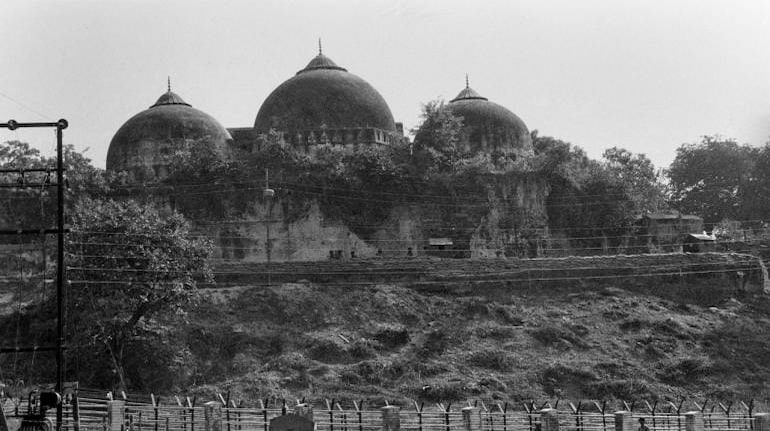



The Supreme Court will hear a plea on the Ram-Janmabhoomi-Babri Masjid case on February 26. The hearing was postponed last month on January 29, due to the unavailability of Justice SA Bobde, one of the five judges in the constitution bench. While we wait to see the outcome of the hearing, we take you through the key events of the decades-old case.
1528: Babri Masjid was built by Mir Baqi, a Mughal commander on the orders of Emperor Babur. Some Hindus claimed that the masjid was made after the temple was demolished.
Dec 1949: Towards the end of December, idols of Lord Ram appeared inside the Babri mosque, allegedly kept there by three Hindus. Both communities decide to file cases after there were widespread protests. The government locks down the area calling it disputed land.
1950: Mahant Paramhans Ramchandra Das, Chef of Ram Janmabhoomi Nyas, and Gopal Singh Visharad file a suit in Faizabad seeking permission to pray before the idols. Prayers were allowed, but the gates were kept closed.
1959: Nirmohi Akhara, one of the parties to the dispute file a suit again to seek prayers.
1961: Sunni Central Board of Waqfs, files a case claiming the mosque and stated that the surrounding area of the mosque was a graveyard.
1984: A group is formed by the Vishwa Hindu Parishad (VHP) who appoint Lal Krishna Advani as their leader for the construction of Ram Temple at the site.
1986: Faizabad district judge ordered the gates be opened for Hindus to offer prayers. Court orders the gates be opened for darshan and puja.
1989: VHP lays the foundation of Ram temple next to Babri Masjid and files a case that the Babri Masjid be shifted somewhere else. Later that year in November, Rajiv Gandhi allows VHP to lay the foundation stone for Ram Temple before the Lok Sabha Elections.
1990: BJP President Advani carried out a Rath-Yatra from Somnath to Ayodhya to educate people but was arrested in Samastipur, Bihar. BJP withdrew alliance from the VP Singh government which led to fresh elections.
1991: BJP comes into power in Uttar Pradesh and increases the momentum to build Ram Temple as Kar Sewaks (volunteers) came together in Ayodhya.
December 6, 1992: The Kar Sewaks demolish the Babri Masjid and build a temple in its place. Riots sparked killing more than 2000 people. The Narasimha government dismisses the BJP govt in UP, MP, Rajasthan and Himachal Pradesh and goes to court for status quo.
1993: Centre passes the Acquisition of Certain Area at Ayodhya Act to acquire the disputed land.
Ismail Faruqui files a case against various aspects of the act.
1994: SC says in the historic Ismail Faruqui case that a mosque was not integral to Islam.
2001: VHP sets up March 2002 as a deadline to start the construction of Ram temple in Ayodhya.
2002: Centre files a suit in the Supreme Court to remove the ‘interim order that bans any religious activity on the disputed land’.
Feb 6, 2002: 59 Kar Sewaks going to Ayodhya in a train from Gujarat where killed in Godhra which sparked communal riots killing over 1000 people.
June 2002: Prime Minister Vajpayee sets up a meeting to hold talks with top Hindu and Muslim leaders.
March 2003: The Allahabad court orders the Archaeological Survey of India (ASI) to excavate the disputed site to determine whether the temple existed there or not.
August 22, 2003: The ASI submits a report that it found remains of a 10th-century temple.
2009: The Liberhan Commission, established by the Narasimha Rao govt., said in its statement that top BJP leaders were involved in the demolition of the Babri Masjid.
2010: The bench suggested all the parties to solve the issue amicably. No party was ready to do so.
September 30, 2010: The Allahabad court distributes the land into three parts each to Nirmohi Akhara sect, the Sunni Central Waqf Board, UP, and Ramlalla Virajman.
2011: The Supreme Court suspends the High court’s order after Hindu and Muslim groups appeal against it.
2017: Suggesting an out-of-court rapprochement among rival parties, Chief Justice of India JS Khekar suggests the parties to solve the issue amicably.
Dec 5, 2017: The SC hears appeals from various parties challenging the 2010 verdict of the Allahabad court on February 8, 2018.
Feb 8, 2018: Kapil Sibal, appearing for the Uttar Pradesh Sunni Central Waqf Board questioned the court about the hurry and requested that the hearing be put off till July 2019.
September 2018: SC declines to refer the case to a five-judge bench. Case to be heard by a newly-constituted three-judge bench on October 29.
October 29, 2018: SC adjourns hearing in the case till January 4, 2019.
January 4, 2019: Court defers hearing till January 10.
January 10: Justice U U Lalit, one of the five-judge Constitution Bench, recused himself from the hearing, after which the SC rescheduled the hearing to January 29.
January 29: The court postpones its hearing as Justice SA Bobde, one of the five-judge Constitution Bench for the case, is not available. The date of the next hearing remains to be declared
February 15: SC decides to hear a fresh plea against the 1993 central law on land acquisition near the disputed site at Ayodhya.
February 26: A hearing by a five-judge constitution bench comprising Chief Justice Ranjan Gogoi and Justices S A Bobde, D Y Chandrachud, Ashok Bhushan and S Abdul Nazeer has been scheduled.
Discover the latest Business News, Sensex, and Nifty updates. Obtain Personal Finance insights, tax queries, and expert opinions on Moneycontrol or download the Moneycontrol App to stay updated!
Find the best of Al News in one place, specially curated for you every weekend.
Stay on top of the latest tech trends and biggest startup news.